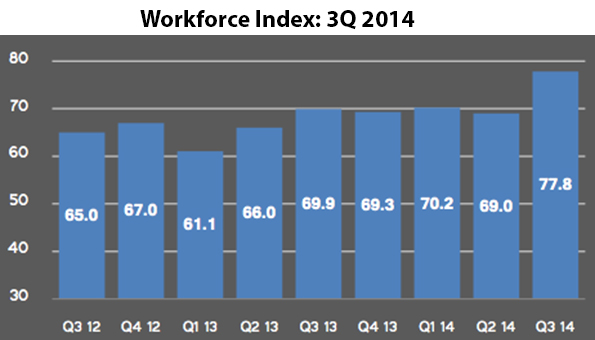The People Report Workforce Index, which measures expected market pressures on restaurant employment, reached its highest level for the upcoming third quarter since it was established in 2006.
The third-quarter overall index rose to 77.8, from 69.0 in the second quarter. Vacancies at the management level and turnover rates both increased.
RELATED
• Restaurant employee turnover, vacancies persist in 2Q
• Survey: Restaurant workforce challenges continue in 1Q
• More restaurant H.R. news
The Workforce Index is produced by Dallas-based People Report and is based on surveys of human resources departments and recruiters in the restaurant industry. The index has a baseline value of 50, with results over that level indicating increased pressures on five components: employment levels, recruiting difficulty, vacancies, employment expectations and turnover. Results are based on expectations for the quarter underway.
“We’ve seen a gradual increase the past few quarters,” said Michael Harms, executive director of operations for People Report and sister TDn2K company Black Box Intelligence. “Restaurant operators are starting to feel the staffing pinch of the tightening labor market.”
The index’s Employment Levels component rose to 81.3, from 64.4 in the second quarter, which the survey noted was “representing strong job growth across all segments.” Recruiting difficulty also rose to 74.4, from 67.5, which the survey noted as “an increasing challenge at the management level.”
“We saw a lot of all-time highs across the index,” Harms said. “Seeing numbers in the upper 80s and 90s is very, very rare.”
Nationally, the U.S. unemployment rate slipped from 6.7 percent at the beginning of the year to 6.2 percent at the end of the second quarter. The economy added 736,000 jobs in the second quarter, an increase from 569,000 in first quarter, and represented the strongest quarterly job growth in more than two years.
“All the arrows point to an improving labor market, and that’s exactly what we’re seeing,” Harms said.
The foodservice industry added 79,900 jobs during second quarter, rising from 78,700 in first quarter. People Report noted that this restaurant growth was less than the 86,000 jobs the industry had averaged each quarter since the start of 2012.

According to the Workforce Index, 70 percent of restaurant companies added staff at the hourly level in the second quarter, an increase from 41 percent in first quarter, and only three percent reduced staff. At the management level, 53 percent added staff and 5 percent made reductions.
“There’s growing pressure, especially at the management level,” Harms said. “There is a growing demand and they have increasing options both inside and outside the industry.”
Industry turnover levels have been increasing at both the hourly and management levels in recent months, the index noted: 56 percent of companies experienced rising turnover rates at the hourly level in second quarter, and 39 percent of companies saw increases at the management level.
“We’ve seen increasing turnover rates in all industry segments at both the hourly and management levels,” Harms explained. “Turnover is a lagging indicator, so you can expect that to rise. Fast casual and quick service are at the tip of the spear, and they are already seeing increases in turnover that will probably trickle into casual and fine dining as well.”
Vacancies at the hourly level remained consistent for the third consecutive quarter, with 37 percent of those surveyed experiencing an increase and 59 percent seeing no change. However, vacancies at the management level rose, with 53 percent of companies reporting an increase in the second quarter, an increase from 50 percent in first quarter and 33 percent in fourth quarter 2013.
Overall Workforce Index rankings by industry category for the third quarter rose in all four segments compared with the second quarter:
• Quick service increased to 70.7, from 66.1
• Limited service/fast casual/family dining rose to 85, from 70
• Casual dining increased to 74.2, from 65.9.
• Fine dining/high volume rose to 82.6, from 74.2
“Fast casual has been growing, and we’re seeing that in their staffing concerns,” Harms explained. “In fine dining, they took a considerable hit when the economy turned down a few years ago. But as the economy improves, people are going for those dinner and we’re seeing that in the numbers as well.”
Contact Ron Ruggless at [email protected]
Follow him on Twitter: @RonRuggless


